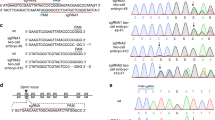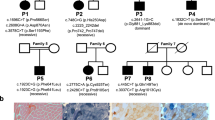Abstract
IT is a general principle of mammalian biochemical genetics that enzymatic activity is proportional to gene dosage; that is, co-dominance of the biochemical phenotype is usual in heterozygotes. A well studied exception is the lethal albino locus of mice. The radiation-induced lethal albino alleles cause prenatal or early neonatal death. The mutations are unusual in their lack of gene dosage effect. Four alleles (c14cos, c112K, c65K, c3H) that are expressed in newborns as absence of pigment, hypoglycaemia, and neonatal death are associated with glucose 6-phosphatase deficiency1,2. Heterozygotes distinguishable by pigment dilution have the same glucose 6-phosphatase levels as normal homozygotes in a number of situations, including enzyme induction with corticoids, glucagon, dibutyryl cyclic AMP, by producing alloxan diabetes, and during normal post-natal development3,4. Four other enzymes (tyrosine aminotransferase, serine dehydratase, bilirubin glucuronyl transferase, and spectrophotometrically-determined cytochrome P-450) that are deficient in lethal albino homozygotes are present in normal levels in heterozygotes (refs 3–5 and M. M. Thaler, R. P. E., and S. Gluecksohn-Waelsch, in preparation). There is evidence that mutation of something other than structural genes for the enzymes is involved. Residual amounts of glucose 6-phosphatase and tyrosine aminotransferase are present in lethal albino homozygotes. Complementation of these lethal albino alleles with two additional lethal albino alleles, c6H and c25H obtained from Harwell, resulted in normal enzyme levels4,5. Also, abnormalities of endoplasmic reticulum of lethal albino hepatocytes are strikingly evident on electron microscopy6. Enzymes deficient in homozygotes are either cyclic AMP-induced or microsomal. A mutation in the gene for a membrane structural protein or in the gene for a component of the cyclic AMP induction system has been suggested as an underlying defect which might account for the deficiency of a number of enzymes and the failure to demonstrate heterozvgote dosage effect, although biochemical and immunological techniques have not yet detected any abnormality (R. P. E., P. Siekevitz, K. Jacobs, and S. Gluecksohn-Waelsch, in preparation).
This is a preview of subscription content, access via your institution
Access options
Subscribe to this journal
Receive 51 print issues and online access
$199.00 per year
only $3.90 per issue
Buy this article
- Purchase on Springer Link
- Instant access to full article PDF
Prices may be subject to local taxes which are calculated during checkout
Similar content being viewed by others
References
Erickson, R. P., Gluesksohn-Waelsch, S., and Cori, C. J., Proc. natn. Acad. Sci. U.S.A., 59, 437 (1968).
Gluecksohn-Waelsch, S., and Cori, C. J., Biochem. Genet., 4, 195 (1970).
Russell, J. D., Cori, C. J., and Gluecksohn-Waelsch, S., FEBS Symposium 19: 315 (1969).
Thorndike, J., Trigg, M. J., Stockert, R., Gluecksohn-Waelsch, S., and Cori, C. J., Biochem. Genet., 9, 25 (1973).
Gluecksohn-Wælsch, S., Schiffman, M. B., Thorndike, J., and Cori, C. F., Proc. natn. Acad. Sci. U.S.A. (in the press).
Trigg, M. J., and Gluecksohn-Waelsch, S., J. Cell Biol., 58, 549 (1973).
Erickson, R. P., Eicher, E. M., and Gluecksohn-Waelsch, S., Nature, 248, 416 (1973).
Brdiczka, D., and Pette, D., Eur. J. Biochem., 19, 546 (1971).
Tedesco, T. A., and Mellman, W. J., Science N.Y., 172, 128 (1971).
Barath, Z., and Kuntzel, H., Proc. natn. Acad. Sci., U.S.A., 69, 1371 (1972).
Van Heyningen, J., Craig, I., and Bodmer, W., Nature, 242, 509 (1973).
Author information
Authors and Affiliations
Rights and permissions
About this article
Cite this article
DIAMOND, R., ERICKSON, R. Gene dosage in a deletion for a nuclear-coded, mitochondrial enzyme. Nature 248, 418–419 (1974). https://doi.org/10.1038/248418a0
Received:
Issue Date:
DOI: https://doi.org/10.1038/248418a0
This article is cited by
-
Glycogen storage diseases in animals and their potential value as models of human disease
Journal of Inherited Metabolic Disease (1983)
-
Effect of gene dosage on expression of mitochondrial malic enzyme activity in the mouse
Nature (1978)
Comments
By submitting a comment you agree to abide by our Terms and Community Guidelines. If you find something abusive or that does not comply with our terms or guidelines please flag it as inappropriate.



